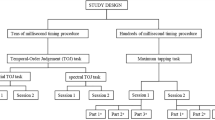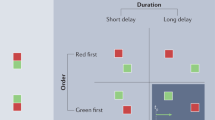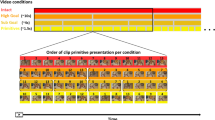Abstract
Timing is crucial to many aspects of human performance. To better understand its neural underpinnings, we used event-related fMRI to examine the time course of activation associated with different components of a time perception task. We distinguished systems associated with encoding time intervals from those related to comparing intervals and implementing a response. Activation in the basal ganglia occurred early, and was uniquely associated with encoding time intervals, whereas cerebellar activation unfolded late, suggesting an involvement in processes other than explicit timing. Early cortical activation associated with encoding of time intervals was observed in the right inferior parietal cortex and bilateral premotor cortex, implicating these systems in attention and temporary maintenance of intervals. Late activation in the right dorsolateral prefrontal cortex emerged during comparison of time intervals. Our results illustrate a dynamic network of cortical-subcortical activation associated with different components of temporal information processing.
This is a preview of subscription content, access via your institution
Access options
Subscribe to this journal
Receive 12 print issues and online access
$209.00 per year
only $17.42 per issue
Buy this article
- Purchase on Springer Link
- Instant access to full article PDF
Prices may be subject to local taxes which are calculated during checkout






Similar content being viewed by others
References
Wearden, J. H. “Beyond the fields we know. . .”: Exploring and developing scalar timing theory. Behavioural Processes 45, 3–21 (1999).
Gibbon, J., Church, R. M. & Meck, W. H. Scalar timing in memory. Ann. NY Acad. Sci. 423, 52–77 (1984).
Matell, M. S. & Meck, W. H. Neuropsychological mechanisms of interval timing behavior. Bioessays 22, 94–103 (2000).
Brown, S. W. Time perception and attention: the effects of prospective versus retrospective paradigms and task demands on perceived duration. Percept. Psychophys. 38, 115–124 (1985).
Zakay, D. & Block, R. A. in Time, Internal Clocks, and Movement (eds. Pastor, M. A. & Artieda, J.) 143–164 (Elsevier Science BV, Amsterdam, 1996).
Baddeley, A. Working Memory (Clarendon/Oxford Univ. Press, Oxford, 1986).
Harrington, D. L. & Haaland, K. Y. Neural underpinnings of temporal processing: A review of focal lesion, pharmacological, and functional imaging research. Rev. Neurosci. 10, 91–116 (1999).
Narabayashi, H. & Nakamura, R. in Clinical Neurophysiology of Parkinsonism. (eds. Delwaide, P. J. & Agnoli, A.) 45–57 (Elsevier, New York, 1985).
Manto, M. Pathophysiology of cerebellar dysmetria: the imbalance between the agonist and the antagonist electromyographic activities. Eur. Neurol. 36, 333–337 (1996).
Artieda, J., Pastor, M. A., Lacruz, F. & Obeso, J. A. Temporal discrimination is abnormal in Parkinson's disease. Brain 115, 199–210 (1992).
Harrington, D. L., Haaland, K. Y. & Hermanowicz, N. Temporal processing in the basal ganglia. Neuropsycholologia 12, 3–12 (1998).
Maricq, A. V. & Church, R. M. The differential effects of haloperidol and methamphetamine on time estimation in the rat. Psychopharmacology 79, 10–15 (1983).
Meck, W. H. Affinity for the dopamine D2 receptor predicts neuroleptic potency in decreasing the speed of an internal clock. Pharmacol. Biochem. Behav. 25, 1185–1189 (1986).
Casini, L. & Ivry, R. Effects of divided attention on temporal processing in patients with lesions of the cerebellum or frontal lobe. Neuropsychologia 13, 10–21 (1999).
Ivry, R. B., Keele, S. W. & Diener, H. C. Dissociation of the lateral and medial cerebellum in movement timing and movement execution. Exp. Brain Res. 73, 167–180 (1988).
Ivry, R. B. & Keele, S. W. Timing functions of the cerebellum. J. Cogn. Neurosci. 1, 136–152 (1989).
Malapani, C., Dubois, B., Rancurel, G. & Gibbon, J. Cerebellar dysfunctions of temporal processing in the seconds range in humans. Neuroreport 9, 3907–3912 (1998).
Mangels, J. A., Ivry, R. & Shimizu, N. Dissociable contributions of the prefrontal and neocerebellar cortex to time perception. Cogn. Brain Res. 7, 15–39 (1998).
Goldman-Rakic, P. S. Regional and cellular fractionation of working memory. Proc. Natl. Acad. Sci. USA 93, 13473–13480 (1996).
Smith, E. & Jonides, J. Storage and executive processes in the frontal lobes. Science 283, 1657–1661 (1999).
Harrington, D. L., Haaland, K. Y. & Knight, R. T. Cortical networks underlying mechanisms of time perception. J. Neurosci. 18, 1085–1095 (1998).
Meck, W. H., Church, R. M., Wenk, G. L. & Olton, D. S. Nucleus basalis magnocellularis and medial septal area lesions differentially impair temporal memory. J. Neurosci. 7, 3505–3511 (1987).
Halsband, U., Ito, N., Tanji, J. & Freund, H. J. The role of premotor cortex and the supplementary motor area in the temporal control of movement in man. Brain 116, 243–266 (1993).
Larsson, J., Gulyas, B. & Roland, P. E. Cortical representation of self-paced finger movement. Neuroreport 7, 463–468 (1996).
Lejeune, H. et al. The basic pattern of activation in motor and sensory temporal tasks: positron emission tomography data. Neurosci. Lett. 235, 21–24 (1997).
Penhune, V. B., Zatorre, R. J. & Evans, A. Cerebellar contributions to motor timing: a PET study of auditory and visual rhythm reproduction. J. Cogn. Neurosci. 10, 752–765 (1998).
Rao, S. M. et al. Distributed neural systems underlying the timing of movements. J. Neurosci. 17, 5528–5535 (1997).
Jueptner, I. H. et al. Localization of a cerebellar timing process using PET. Neurology 45, 1540–1545 (1995).
Maquet, P. et al. Brain activation induced by estimation of duration: a PET study. Neuroimage 3, 119–126 (1996).
O'Boyle, D. J., Freeman, J. S. & Cody, F. W. J. The accuracy and precision of timing of self-paced, repetitive movements in subjects with Parkinson's disease. Brain 119, 51–70 (1996).
Pastor, M. A., Artieda, J., Jahanshahi, M. & Obeso, J. A. Performance of repetitive wrist movements in Parkinson's disease. Brain 115, 875–891 (1992).
Malapani, C. et al. Coupled temporal memories in Parkinson's disease: a dopamine-related dysfunction. J. Cogn. Neurosci. 10, 316–331 (1998).
Ivry, R. The representation of temporal information in perception and motor control. Curr. Opin. Neurobiol. 6, 851–857 (1996).
Casini, L. & Macar, F. Effects of attention manipulation on judgments of duration and of intensity in the visual modality. Mem. Cognit. 25, 812–818 (1997).
Gao, J. H. et al. Cerebellum implicated in sensory acquisition and discrimination rather than motor control. Science 272, 545–547 (1996).
Desmond, J. E., Gabrieli, J. D. E., Wagner, A. D., Ginier, B. L. & Glover, G. H. Lobular patterns of cerebellar activation in verbal working-memory and finger-tapping tasks as revealed by functional MRI. J. Neurosci. 17, 9675–9685 (1997).
Schmahmann, J. D. The Cerebellum and Cognition (Academic, New York, 1997).
Bower, J. M. Is the cerebellum sensory for motor's sake, or motor for sensory's sake: the view from the whiskers of a rat? Prog. Brain Res. 114, 463–496 (1997).
Brodal, P. The ponto-cerebellar projection in the rhesus monkey: an experimental study with retrograde axonal transport of horseradish peroxidase. Neuroscience 4, 193–208 (1979).
Alexander, G. E., DeLong, M. R. & Strick, P. L. in Annual Review of Neuroscience (ed. Cowan, W. M.) 357–381 (Society for Neuroscience, Washington, DC, 1986).
Brunia, C. & Damen, E. Distribution of slow brain potentials related to motor preparation and stimulus anticipation in a time estimation task. Electroencephalogr. Clin. Neurophysiol. 69, 234–243 (1988).
Mohl, W. & Pfurtscheller, G. The role of the right parietal region in a movement time estimation task. Neuroreport 2, 309–312 (1991).
Posner, M. I., Walker, J. A., Friedrich, F. J. & Rafal, R. D. Effects of parietal injury on covert orienting of attention. J. Neurosci. 4, 1863–1874 (1984).
Cavada, C. & Goldman-Rakic, P. S. Topographic segregation of corticostriatal projections from posterior parietal subdivisions in the macaque monkey. Neuroscience 42, 683–696 (1991).
Cohen, J. et al. Temporal dynamics of brain activation during a working memory task. Nature 386, 604–607 (1997).
Awh, E., Smith, E. E. & Jonides, J. Human rehearsal processes and the frontal lobes: PET evidence. Ann. NY Acad. Sci. 769, 97–117 (1995).
Prabhakaran, V., Narayanan, K., Zhao, Z. & Gabrieli, J. D. E. Integration of diverse information in working memory within the frontal lobe. Nat. Neurosci. 3, 85–90 (2000).
Cox, R. W. AFNI: Software for analysis and visualization of functional magnetic resonance neuroimages. Comput. Biomed. Res. 29, 162–173 (1996).
Talairach, J. & Tournoux, P. Co-Planar Stereotaxic Atlas of the Human Brain (Thieme, New York, 1988).
Forman, S. D. et al. Improved assessment of significant activation in functional magnetic resonance imaging (fMRI): use of a cluster-size threshold. Magn. Reson. Med. 33, 636–647 (1995)
Acknowledgements
This study was funded in part by grants from the Department of Veterans Affairs and National Foundation for Functional Brain Imaging (D.L.H.), the National Institutes of Health (P01 MH51358, R01 MH57836, M01 RR00058) and W.M. Keck Foundation (S.M.R.). We thank R. Cox, E. DeYoe, S. Durgerian, R. Lee, G. Mallory, L. Mead, J. Neitz and B. Ward for their assistance.
Author information
Authors and Affiliations
Corresponding author
Rights and permissions
About this article
Cite this article
Rao, S., Mayer, A. & Harrington, D. The evolution of brain activation during temporal processing. Nat Neurosci 4, 317–323 (2001). https://doi.org/10.1038/85191
Received:
Accepted:
Issue Date:
DOI: https://doi.org/10.1038/85191
This article is cited by
-
Using temperature to analyze the neural basis of a time-based decision
Nature Neuroscience (2023)
-
Subjective perception of time and decision inconsistency in interval effect
Quality & Quantity (2023)
-
The neural bases for timing of durations
Nature Reviews Neuroscience (2022)
-
A neural circuit model for human sensorimotor timing
Nature Communications (2020)
-
Spatiotemporal dynamics of auditory information processing in the insular cortex: an intracranial EEG study using an oddball paradigm
Brain Structure and Function (2020)



